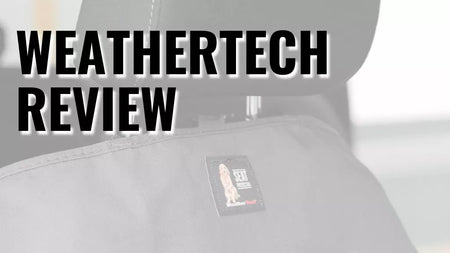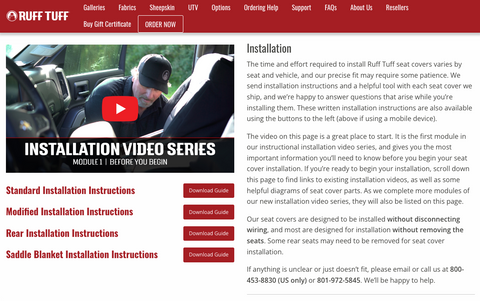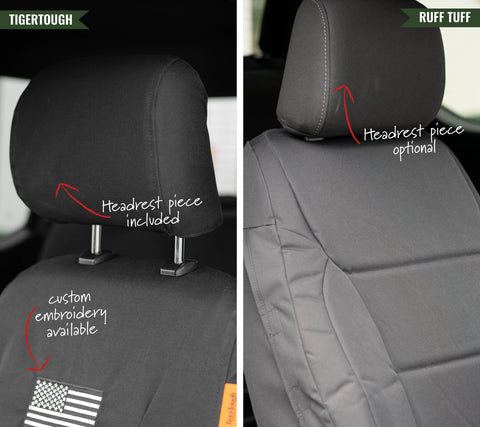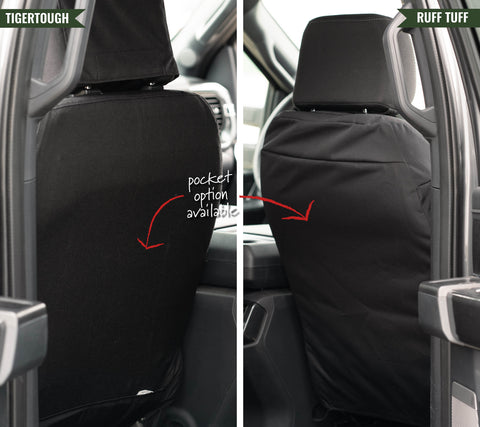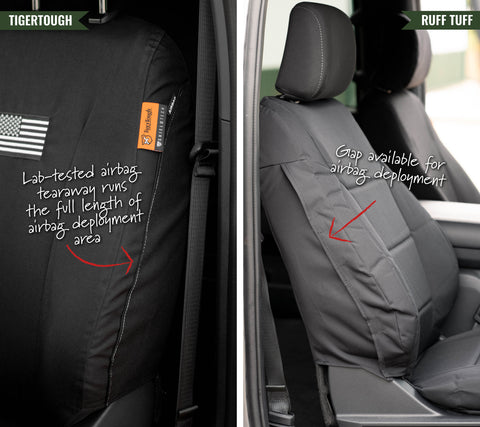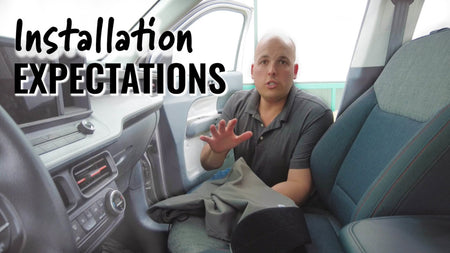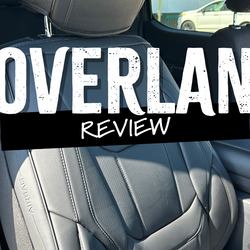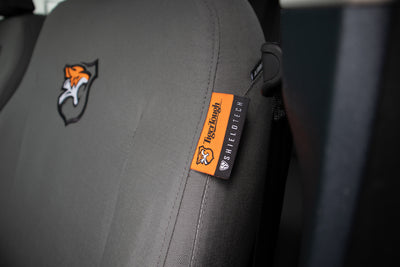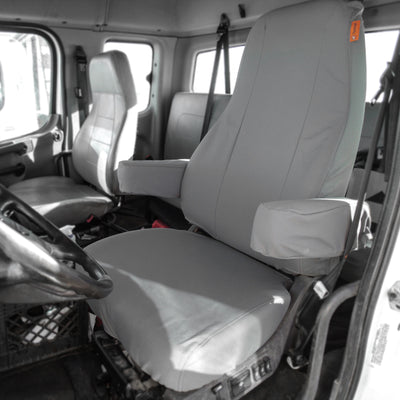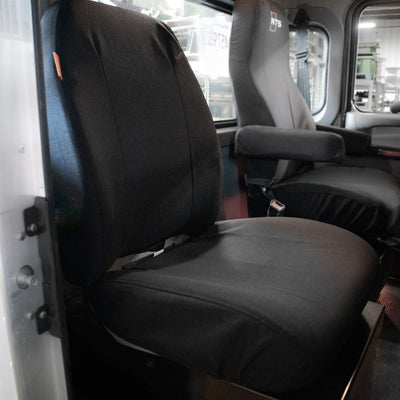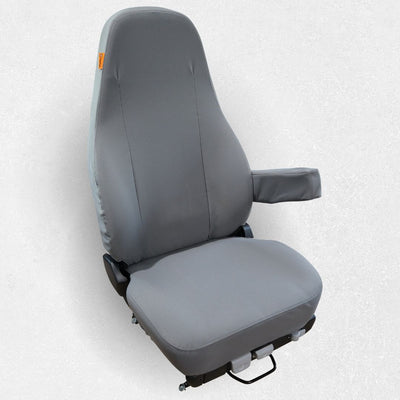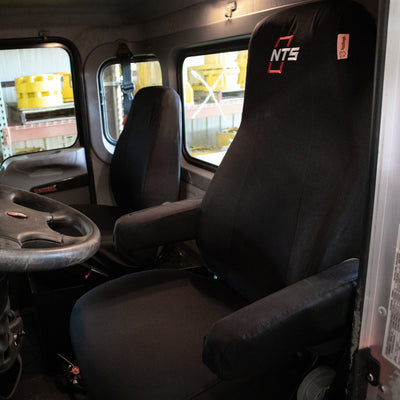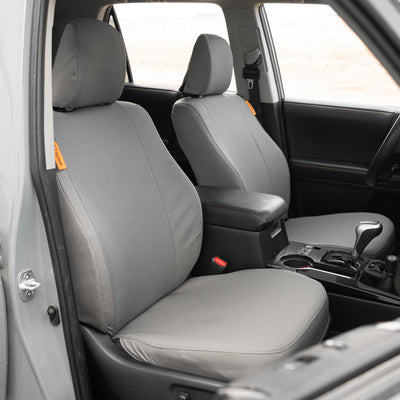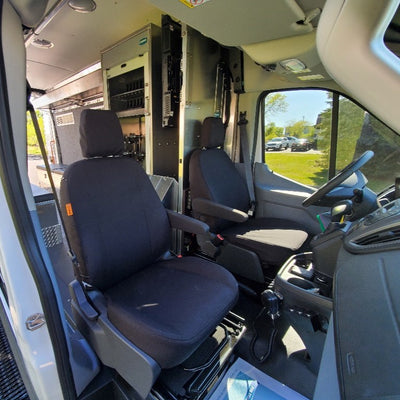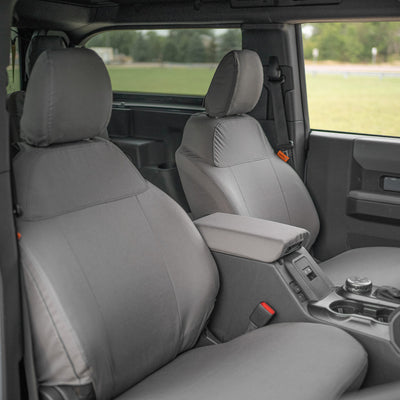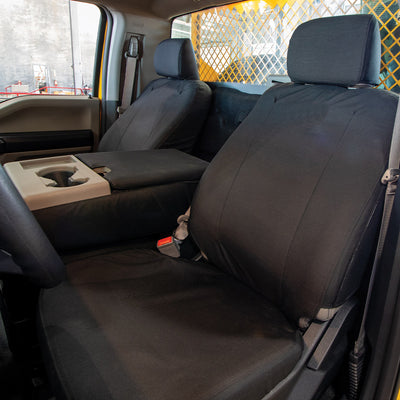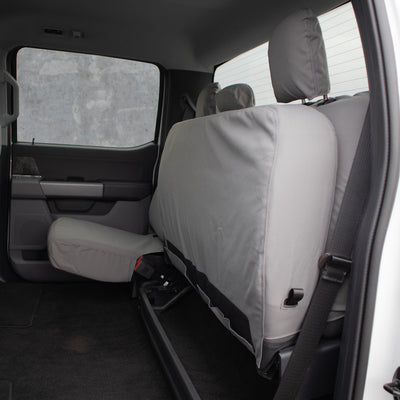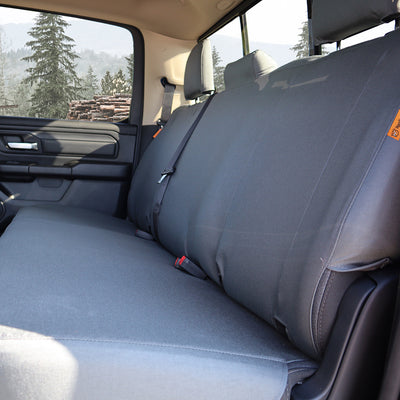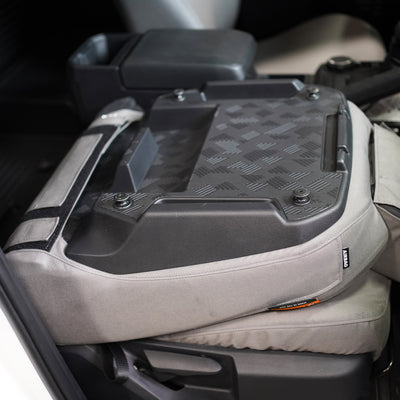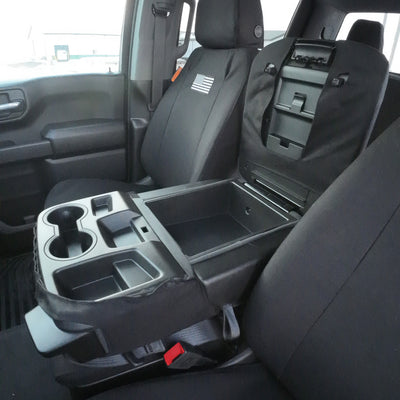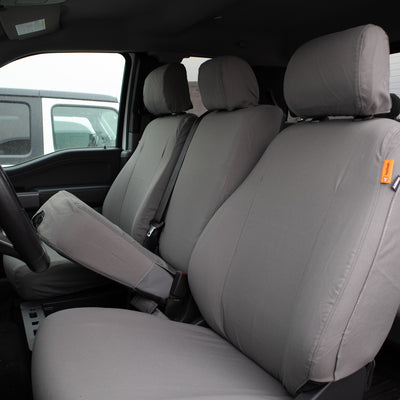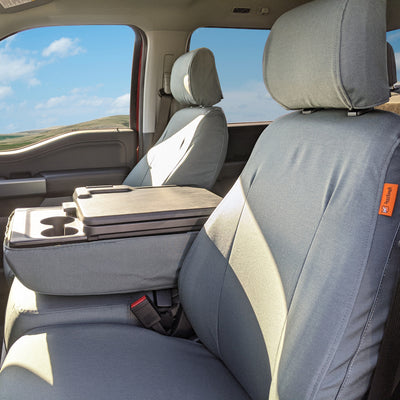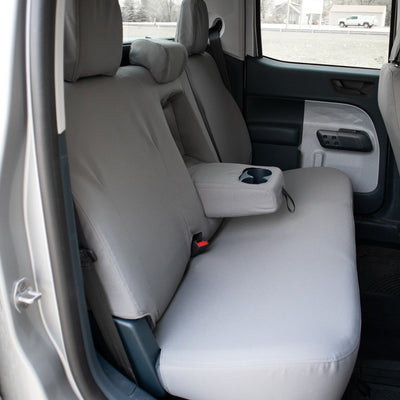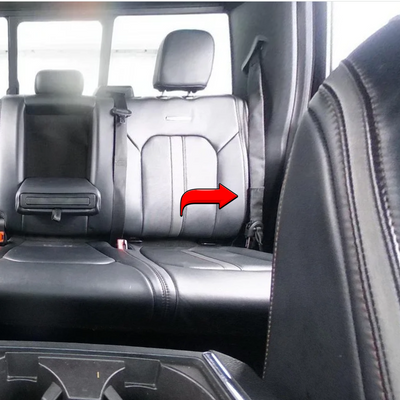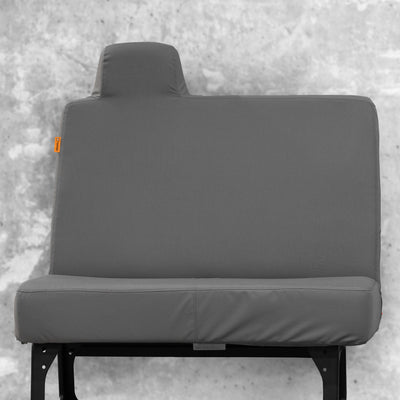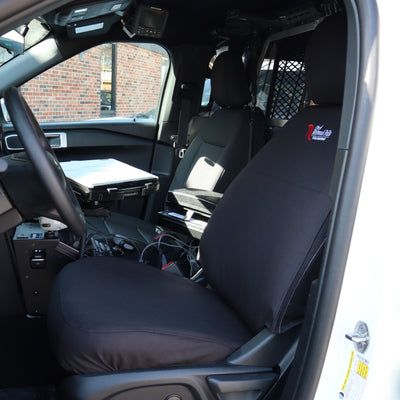It might seem weird that we're reviewing seat covers that aren't ours.
We already compared WeatherTech Seat Protectors with TigerTough seat covers. But we wanted to give these a separate review. After all, if we want to make the best seat covers in America, we better know what other seat cover companies are doing well.
We know WeatherTech makes incredible floormats. They’ve been in the business since 1989 and are well-known in the industry for their floor protection. A few of us at TigerTough even rock their mats in our trucks.
But when we were researching our Best Work Truck Seat Covers article, WeatherTech Seat Protectors were mentioned as an option for work trucks. Since we love their floormats, we had high expectations for their seat covers. So we ordered a single cover to fit a 2023 F150 XLT passenger seat to try our best to give an unbiased review.
Let’s see how it holds up.
Watch the video review
Ordering and shipping
WeatherTech wastes no time in shipping. We received our order in just two days!

The seat cover arrived in a plain brown box. This doesn’t affect our review, but we know their floormats come in a branded box, and it’d be cool to see that same thought put into shipping their covers.
Inside the box was the cover, wrapped in protective plastic, an invoice, and the installation instructions. No swag or fanfare. It was just a straightforward package.
Design and appearance
The weird thing is, WeatherTech does an excellent job of showcasing their Seat Protectors on the rear bench seats of vehicles in their stock photos, but you need to dig a little to find the covers shown on a bucket or captain seat.

But once we installed the set we ordered on our Ford F150, we had that a-ha moment about why WeatherTech didn’t put their bucket seat covers in the spotlight.
It turns out they only offer six different fits for their seat covers–this fit is far from custom, despite searching for a specific vehicle when ordering. It reminds us of those weighted vests the dentist makes you wear before taking x-rays.
This is a one-piece seat cover, so you won’t get an attractive fit.
The lack of a headrest cover doesn’t help the appearance of an apron, so when you open the door, you can immediately tell this is a seat cover. Also, any grime from your head will still transfer to the headrest. That won’t help with resale value.
Fit
It’s crucial to point out that WeatherTech advises you not to install their seat covers on seats with side airbags. A standard consumer probably doesn’t realize that these airbags were being placed in vehicles starting in the 1990s. As of 1997, a mandate was put in place that all passenger-side seats contain airbags.

That means you shouldn’t put WeatherTech Seat Protectors on any passenger seat of a vehicle made after 1998. They could work on airbagless rear captain seats if your vehicle has those, but they wouldn't work on the seats of the Ford F150 we tried them on.

Let’s just skip right past that red flag and move on to the control panels.

The front skirt of the Seat Protectors went over the side control panels of our Ford F150 passenger seat. So if we needed to adjust the seat, we’d have to pick up that fabric curtain to access the controls. That’s not a deal-breaker, but it's inconvenient.
But the back of the seat is a different story.

The back of the seat isn't covered by anything beyond the hook and loop straps that secure the Seat Protector. This might not be a big deal if you don't have passengers in the second row. But either way, it's not going to give you a secure fit.
Despite claiming their seat covers are semi-custom, having six varieties for thousands of different vehicles won’t give you a custom fit.
Manfred from Connecticut was disappointed with how they fit his 2018 Ford F150:
“I found the quality of the material good. The elastic to hold the fabric up against the seat was not very strong and unable to tighten, allowing the back to sag. The ‘grippy’ material on the bottom does not work well with leather seats allowing the bottom to slide forward. It is almost impossible to access the seat belts. There is no way to secure the bottom to the seat allowing the cover to ride up.
“All in all, for a cover that you advertise as a ‘custom’ fit, it is very poorly designed. I have been using the cover for two weeks. For the price and ‘custom’ fit, I expected much better.”
Material
According to their site, the seat covers are “made from a polycotton twill fabric featuring a water-repellent finish, and an extra layer of nylon lining.”
We’re always fans of anything that will protect your seats from spills. Waterproof would be better, but we won’t be upset over water-repellent. Just get to those messes quickly before any liquid seeps into your seats.
But the non-slip backing is questionable. Reviews say that it doesn’t work on leather. Dave tried them on his 2014 Ford F150 with leather interior:
“Purchased cover for backseat. So disappointed. Does not stay in place on the leather seats. Keeps folding up. The whole thing is cheap what we got. I'm sorry....but not good. Seats were full of mud on our trip. A blanket would have served better.”
That grippy material on the back is similar to a foam shelf liner. No, we’re not being snarky; that’s what it’s like.

Installation
Installation was quick. We were able to install it in under three minutes. There’s a strap that goes behind the seat and one that goes under. There’s an additional clip that goes around the headrest. Note that if you don’t have headrests, you won’t be able to install this seat cover.
We’re happy to report that a novice could install these.
Effectiveness
We didn’t do any of our torture tests with these seats, so we suggest checking out the reviews on the WeatherTech site from people who’ve used these covers in action. They’ll be able to tell you how these have held up in the long run.
Spoiler alert: Only 50% of customers would recommend the covers.
Warranty
Here’s where we can give WeatherTech some points. They offer a limited lifetime warranty on their Seat Protectors.
If anything goes wrong with the cover that you couldn’t prevent, WeatherTech will help you out.
Value
The WeatherTech Seat Protectors cost around $300 for a pair of bucket seats. That’s not cheap. And when you consider that the covers don’t protect the back of the seats or the headrest, and you’d have to pay an extra $55 per seat for a seat back protector, you’re looking at over $400 to fully cover your front bucket seats.
If you have $400 to spend on a pair of seat covers, there are other brands we think you’ll be happier with.
Summary
We wanted to like these but just couldn’t.
On rear bench seats, these could work well for pets or equipment. (Especially if you don’t need the middle seat because center seatbelts won’t be accessible.) If you’re not hauling around humans, this could be a good option, and the humanless options seem to be what positive reviewers are using these for.
But even then, WeatherTech reviewers give the Seat Protectors 3.2 stars out of 5. That’s a 64%, and if we were still in high school, they’d be getting a D. Not something we’d brag about.
Let’s face it; seat covers aren’t WeatherTech’s bread and butter. They’re known for floormats and other vehicle accessories. So although we love WeatherTech, we wouldn’t recommend their seat covers, and we’re not just saying that as a seat cover company; we’re saying this based on research, testing, and verified customer reviews.
Mike from Pennsylvania gets how we feel:
“I gotten many items from Weathertech over the years. All top grade. But the front seat protector I just purchased is awful. Looks bad, doesn’t fit well, uses Velcro attachments. Just awful. I have it two weeks. Constantly had to refit and re-adjust Velcro. I gave up and took it off. $150 bucks for an absolute failure. Stick to floor liners. Those work great.”
If you’re ready to invest in seat covers that last, take a look at these favorite brands.
